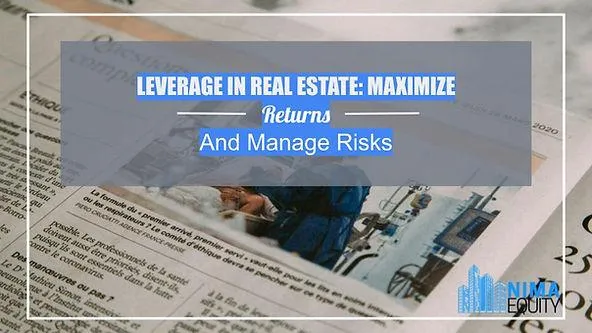
Leverage In Real Estate: Maximize Returns And Manage Risks
Leverage is a powerful strategy in real estate that allows investors to take full advantage of high-value assets using only a small portion of their own money. It’s the strategy behind many successful investors expanding their portfolios and building wealth quickly. But like any strategy, leveraging comes with risks. Understanding how it works and how to use it responsibly is key to maximizing returns and managing potential pitfalls.
In this article, we’ll break down how leverage works, potential risks, and how to manage these risks.
What Is Leverage in Real Estate?
Leverage in real estate means using borrowed money, usually through a mortgage, to purchase a property. Instead of paying the full price upfront, you use a smaller portion of your own money for the down payment and borrow the rest from a lender.
For example, you want to buy a $500,000 property. Instead of paying the entire amount, you might put down $100,000 (20%) as a down payment and finance the remaining $400,000 with a loan. This allows you to control the property and enjoy the benefits of ownership without using up all your cash. Now that you have control over this property, you can take advantage of greater potential returns through appreciation, rental income, and equity growth.
How Leverage Amplifies Returns
Equity Growth: When property values increase, leverage magnifies those gains. Using the $500,000 example, if the property appreciates by 10% (or $50,000), you gain $50,000 in equity. But since you only invested $100,000 of your money, your return on investment (ROI) is 50%, not just 10%.
If you had purchased a $100,000 property with a full cash payment, and it appreciates by 10%, your equity grows by $10,000. However, your ROI is only 10% because you tied up the entire $100,000 upfront.
Cash-on-Cash Returns: Leverage also boosts your cash-on-cash returns. If your property generates $20,000 annually in rental income after expenses, and you invested $100,000 in that $500,000 property, your cash-on-cash return is 20%. If you had paid the entire $500,000 upfront, your return would be only 4%.
The Risks of Leverage
Leverage Can Magnify Losses Too
Leverage can amplify both gains and losses. Let’s use the same $500,000 property example:
You put $100,000 down and take out a $400,000 loan with, let’s say, a 5% annual interest rate.
Your annual interest cost is 5% of $400,000, which equals $20,000.
Here’s what happens if the market drops by 10%:
The property’s value decreases to $450,000 (a $50,000 loss).
You still owe $400,000 on the loan. If you sell, you only get back $50,000 ($450,000 sale price - $400,000 loan).
Subtract the interest you paid. If you held the property for one year, you spent $20,000 on interest, leaving you with $30,000 net.
Net ROI: You’ve lost 70% of your initial investment ($70,000 loss from $100,000 investment after interest).
This is why market downturns can feel more impactful when using leverage. While leverage allows you to control a larger asset and benefit from appreciation, it also means that your equity is at bigger risk if prices fall.
Losses May Affect Your Entire Portfolio
If it comes to a point where the property fails to generate enough income to cover its monthly expenses, you could face negative cash flow. This can become a domino effect if you rely on that cash flow to pay off loans from other properties. The worst-case scenarios for investors who can’t meet their obligations include foreclosures, forced sales, or bankruptcy.
How to Manage the Risks of Using Leverage
Start Conservatively Begin with a lower Loan-to-Value (LTV) ratio, ideally 70-80%. For example, if you’re buying a $500,000 property, aim to put down at least $100,000 to $125,000. This reduces the loan amount, lowering your monthly payments and giving you a safety margin in case of market downturns.
Invest in Properties Wisely While it’s impossible to predict everything, you can reduce risk by researching rental market trends, average occupancy rates, and potential future developments in the area. For example, if a new corporate office or university is being built nearby, it may boost demand for rentals.
Keep an Emergency Fund Always maintain a cash reserve to cover unexpected costs like repairs, vacancies, or emergencies. This safety net can keep you afloat during challenging times.
Avoid Overleveraging Borrow within your means. Use conservative financial models that account for potential downturns or rent reductions. Expanding your portfolio too quickly by heavily leveraging multiple properties can backfire if market conditions change. Grow your investments at a pace that allows you to maintain financial stability.
Leverage is one of the most powerful strategies in real estate investing, but it requires careful decision-making and understanding. It can multiply your returns and help you build wealth quickly, but it can also magnify your losses if used recklessly.
With responsible leverage, you can build a portfolio of income-generating properties. This creates passive income streams, giving you the freedom to step back from active work, pursue other interests, and spend time with the people who matter most to you.
